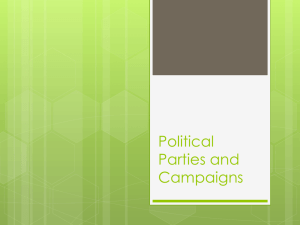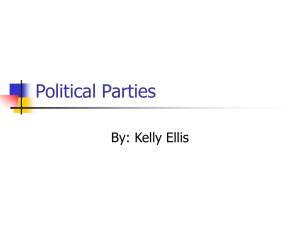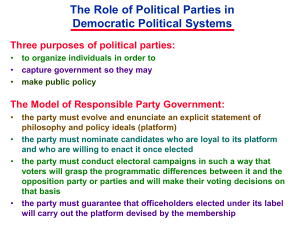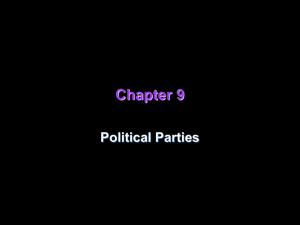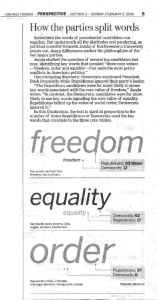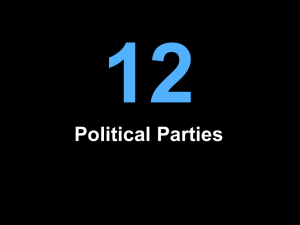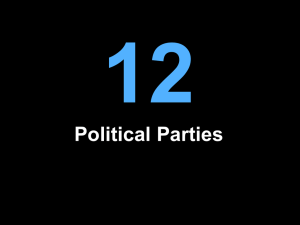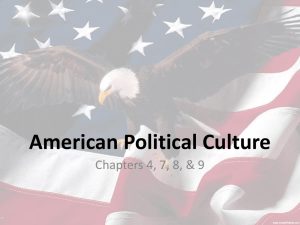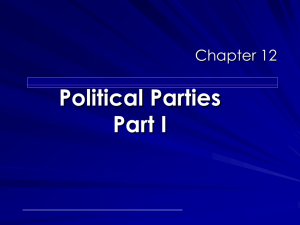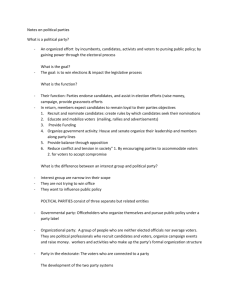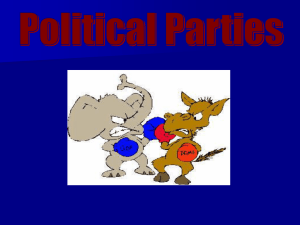Political Parties Power Point
advertisement
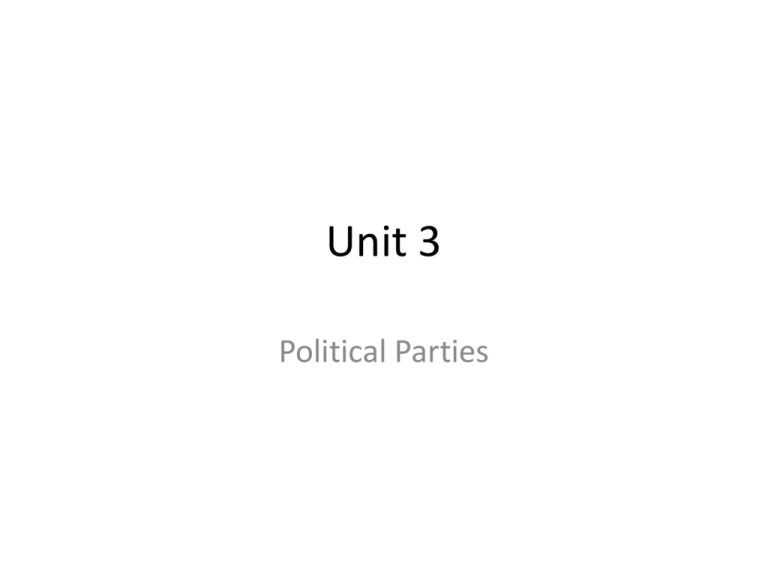
Unit 3 Political Parties What is a political party? • Political parties are the groups that seek to elect candidates to public office • They are the means (how, who, what, why, when) to the end (elections/public officials) • Primary linkage institution – What does this mean? – Linkage institution: connects the people to the government – Gives “label” to the candidate What is a political party? • So, what’s the difference between a political party and an interest group? – Parties are dedicated to electing candidates – Interest groups are dedicated to advancing an issue/cause What are the core functions of political parties? 1. Nominating candidates who can develop public policy What are the core functions of political parties? 2. Running successful campaigns What are the core functions of political parties? 3. Developing a positive image What are the core functions of political parties? 4. Raising money What are the core functions of political parties? 5. Presenting issues in a way the people (electorate) can understand What are the core functions of political parties? 6. Coordinating the implementation of policies they support in the government What are the core functions of political parties? 7. “watchdog” function if they do not succeed in getting their candidate elected Two-Party System • A government system with two dominant parties that compete in national elections Two vs. Multi Party System • Multi-party systems are much more common • Why does the U.S. have a two-party system? – Plurality system: the person who gets the most votes wins, doesn’t have to be a majority – So, in the U.S., there is rarely a need for run-off elections or alliances, like in other countries. A party only has one shot at winning, so they make all the alliances they can in the beginning (coalitions within parties) – Public opinion: can generally be divided into the two major divisions Two vs. Multi Party System • In a two party system power is much less fragmented and there are fewer alliances Coalitions • Instead of alliances like a multi-party system, the two major parties have coalitions within the party • Democrats: African-Americans, Hispanic, Jewish people, Union members, poor • Republicans: Business, Southerners, Christian groups Effects of Two Party System • 3rd (minor) parties and their ideas are either marginalized or incorporated into the major party platforms Divided Government • Gridlock that occurs because one party controls legislative branch and one controls executive branch • Why doesn’t this occur in a parliamentary system? – Majority in the legislative branch chooses the executive Organization of Political Parties • State parties are independent of national party organization, but receive directives and follow example of national party • Due to federalism, national parties are coalitions of state and local organizations • National convention: meets every four years to nominate a presidential candidate • National committee: manages affairs between conventions; made up of delegates from each state Decline in Power • Elections have become more candidate centered and less party centered • The party machine has lost its power (party machine = money and patronage) – now candidates are more likely than before to deviate from the “party line” to appeal to voters in certain areas – Candidates raise their own funds and use their own consultants – Media focuses on the candidate – Parties have lost some control over candidates because of primaries Third (Minor) Parties • Rarely win national office • Usually adopt one issue or small set of issues that drive their existence (sectionalism, economic protest, etc.) Obstacles to 3rd Party Success • Issues absorbed by major parties • Requirements (amount of support) to get on ballots • Lack of name recognition • Lack of resources (funding and people) • Electoral college is winner-take-all • People don’t want to “waste” their vote • Lack of media coverage Role of 3rd Party • Biggest is to be a policy innovator, calls the public attention to their issue • Example: Ross Perot and balancing the budget • Third parties can also be “spoilers” and take votes away from the majority party – Perot in 1992 – Nader in 2000 Realignment • Periods when a major, lasting shift occurs in the coalitions supporting one or both parties • Two kinds: 1. Major defeat of a party so that it dissipates and a new party emerges (1860) 2. Existing parties continue but voters switch loyalty (1896, 1932) Realignment • Why does it happen? - issues replace traditional basis of party identification - new voters lured into an existing party coalition ** Less common now in the era of candidatecentered campaigns Periods of Realignment • 1860 – Whig Party collapses and Republicans under Lincoln win – Slavery: Lincoln and Republicans (opposed), Democrats (split on slavery); Civil war fixes loyalties • 1896 – Economics: Greenbackers/Populist issues: Democrats (William Jennings Bryan) defeated by Republican McKinley • 1932 – because of Great Depression, New Deal coalition is formed; Democrats take urban workers, African Americans and Jewish away from Republicans • Another eventual side effect of that shift (and Civil Rights, etc.) is that the South has shifted from Democratic to Republican Dealignment • The tendency for voters to not identify with either party, but to call themselves “independents” • Candidates are much more focused on issues and image rather than party message • Dealignment has increased steadily since 1968, more voters are independent and more split ticket voting, as well
